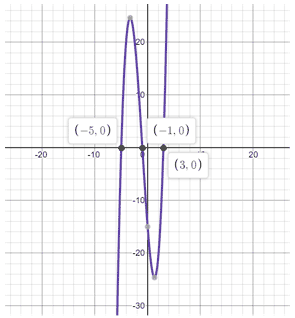Zeros of a function
The zeros of a function, also referred to as roots or x-intercepts, are the x-values at which the value of the function is 0 (f(x) = 0). The zeros of a function can be thought of as the input values that result in an output of 0. It is worth noting that not all functions have real zeros.
Example
Find the zeros of f(x) = x + 5:
Set f(x) equal to 0:
x + 5 = 0
x = -5
There is a zero at x = -5.
How to find the zeros of a function
There are a number of different ways to find the zeros of a function, depending on the type of function. For simpler functions, it is relatively easy to set f(x) = 0 and solve for x, such as in the example above. The more complex the function, the more difficult it is to find its zeros; the principle remains the same however: set the function equal to zero and solve for x. In certain cases, factoring and the quadratic formula can be used to find the zeros of a function.
Find the zeros by factoring
If a function can be factored by grouping, setting each factor equal to 0 then solving for x will yield the zeros of a function.
Example
Find the zeros of the function f(x) = x2 - 3x + 2 by factoring.
Factor:
x2 - 3x + 2 = (x - 1)(x - 2)
Set the factors equal to 0:
(x - 1)(x - 2) = 0
x - 1 = 0 and x - 2 = 0
x = 1 and x = 2
Therefore, the function x2 - 3x + 2 has zeros at x = 1, 2
Find the zeros using the quadratic formula
Quadratic equations are studied fairly thoroughly in algebra in part due to the prevalence of complex equations that can be reduced to quadratic equations. Since any quadratic equation can be solved using the quadratic formula, it is possible to find the zero of any quadratic equation by putting it in the form of the general quadratic equation,
ax2 + bx + c = 0,
then using the quadratic formula.
Example
Find the zeros of 2x(x - 4) = -4 using the quadratic formula.
Get f(x) into the general form of a quadratic equation:
f(x) = 2x2 - 8x + 4 = 0
Plug it into the quadratic formula:
Therefore f(x) has zeros at x = 2 + √2 and 2 - √2.
Find the zeros on a graph
On a graph, the zeros of a function occur when the curve crosses the x-axis. Therefore, all zeros will have an ordered pair of the form (x, 0).
Example
The graph below has zeros at x = -5, -1, 3

It is worth noting that just because the graph of a function doesn't cross the x-axis doesn't necessarily mean that the function does not have any zeros. It only means that the function has no real zeros, but it may have complex zeros.
